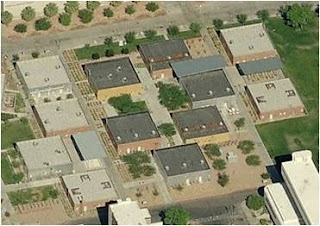•To investigate different roof system options to reduce the cooling loads and overall energy use of the Central Desert Complex (CDC).
Rationale & Background:
The rooftops of the CDC provide an excellent opportunity to study the viability of nontraditional roof materials/systems in a desert environment.
The CDC was conceived as a series of temporary structures to accommodate university and faculty offices. The 12 structures included in the CDC have the same floor area and similar internal gains, making them therefore good candidates for a side-by-side comparison of passive and active roof systems.
The NEAT Lab at the School of Architecture is currently evaluating the thermal performance of both green roofs and roofponds in small-scale test cells.
---------------------------BEFORE ----------------------------------
-----------------------------AFTER--------------------------------
Research Proposal Information:
•12 buildings, 60’ x 60’ each (3,600 ft2).
•Similar uses: offices and labs.
Systems to be Tested:
•Green Roofs: Green roofs require little maintenance and provide storm water retention as well as insulation resulting in reduced cooling loads.
•Radiant Panels: Radiant ceiling panels can be successfully used to cool (and heat) the CDC offices using less energy.
•Roofponds: Heating and cooling can be provided by installing water containers located on the roof to absorb solar energy (winter) or internally produced heat (summer), thus reducing the energy used for heating and cooling.
•On-site energy savings: YES
•Off-site water savings: YES
•Similar uses: offices and labs.
Systems to be Tested:
•Green Roofs: Green roofs require little maintenance and provide storm water retention as well as insulation resulting in reduced cooling loads.
•Radiant Panels: Radiant ceiling panels can be successfully used to cool (and heat) the CDC offices using less energy.
•Roofponds: Heating and cooling can be provided by installing water containers located on the roof to absorb solar energy (winter) or internally produced heat (summer), thus reducing the energy used for heating and cooling.
•On-site energy savings: YES
•Off-site water savings: YES
Case Studies / Precedents:
•Natural Energies Advanced Technologies
Laboratory
www.unlv.edu/labs/neatl
•Green Roof Systems in Athens, Greece
Renewable Energy- Volume 33, Issue 1, January 2008, Pages 173-177
• ASLA Headquarters in Washington, D.C.
http://www.asla.org/land/050205/greenroofcentral.html




No comments:
Post a Comment